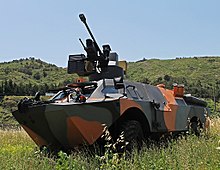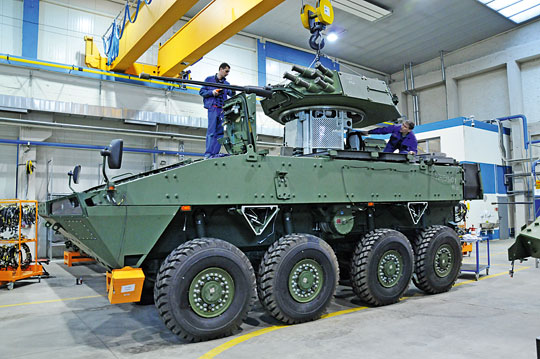
15 years of KTO Rosomak in Siemianowice Silesian Czech Republic. one

From December 2004 to September 30 of this year, Rosomak SA plants supplied the Polish Armed Forces with 841 Rosomak wheeled armored personnel carriers and vehicles based on them. In the photo (from left to right): Rosomak-WRT technical reconnaissance vehicle, Rosomak-WEM ambulance vehicle, Rosomak wheeled infantry fighting vehicle.
This December it will be 15 years since the then Wojskowe Zakłady Mechaniczne SA in Siemianowice Śląskie (now Rosomak SA) handed over to the Polish armed forces the first Rosomak wheeled combat vehicle built in Poland, starting from the stage of welding the hull plates. Although the first nine vehicles - three combat and six base - were seized a year earlier, in December 2004, nevertheless they were from several dozen lots produced at the Finnish plant Patria Vehicles Oy in Hämeenlinna. Thus, the December date of 2005, from the point of view of the plants in Semyanovitsy, is no less important, and perhaps even more important, because it formally initiated the licensed production of Rosomax and the ongoing process of Polonization of this structure, which continues to this day. day.
The decision to choose the offer of Wojskowe Zakłady Mechaniczne in a two-stage tender for a new wheeled armored personnel carrier (APC) announced on August 14, 2001 by the Department of Armaments Policy of the Ministry of National Defense was taken in the tender commission of the Ministry of National Defense on December 10, 2002 by a company from Siemianowice Śląskie offered an AMV car (XC-360) from Patria Vehicles Oy from Finland. The delivery of 690 cars of this type planned for purchase was to cost PLN 4,925 billion gross, the Polonization level was to be 32%, and the declared warranty period was 42 months. WZM offers have been set at 76,19. Competitive offers of Huta Stalowa Wola SA (MOWAG / GMC Piranha IIIC transporter) and Ośrodek Badawczo-Rozwojowe Urządzeń Mechanicznych “OBRUM” Sp. z oo (Steyr Pandur II) received 68,3 points respectively. and 43,24 points, so the advantage was obvious. It should be noted that in 2002 the vehicles underwent comparative ground tests in Poland, although they did not fully meet the tactical and technical requirements, and only the Pandur II was equipped with a two-man turret with a 30-mm cannon - a requirement for using this configuration was only in the revised requirements accompanying the invitation to participate in the final stage of the tender, which was issued on August 2, 2002, after the completion of the main stages of comparative studies.

Combat Rosomak on the assembly line of the Rosomak SA plant in Siemianowice-Slańsk. The integration of the HITFIST-30P tower system continues.
At a press conference held at the headquarters of the Ministry of National Defense on December 20, 2002, the commission's verdict was announced and the victory in the WZM tender with the Patria machine, the combat version of which was supposed to be armed with a two-seater. mm gun Mk30 Bushmaster II. Of the 30 machines, 44 were to be equipped with it (the cost of the tower itself was then determined at a rate of 690% of the price of the entire machine), 313 with a remotely controlled station made of 52 mm fiberglass, and the remaining 87 were represented by the so-called basic version (on their basis, specialized options were to be developed, including 12,7 in a 290 × 32 layout).
On April 15, 2003, the Ministry of National Defense signed a contract with Wojskowe Zakłady Mechaniczne for the supply of 690 vehicles in 2004–2013, of which: 313 in a combat version with HITFIST-30 turrets (96 of them with Spike LR ATGM launchers), 377 base vehicles under construction specialized vehicles (125 armored personnel carriers with a remote-controlled post with 12,7-mm launchers, 78 tactical command vehicles, 41 ambulance vehicles, 23 artillery vehicles, 34 technical assistance vehicles, 22 engineering support vehicles, five engineering reconnaissance vehicles, 17 pollution detection vehicles, 32 vehicles in the 6×6 version as combat reconnaissance vehicles in the command and linear versions).
The basic contract with the Ministry of National Defense made it possible to conclude contracts between WZM and Oto Melara, as well as Patria for the supply of turrets and chassis. The documents were signed respectively on June 6 and 30, 2013. It is worth noting here that before the start of the production of vehicles and towers in Poland, both foreign companies had to supply 40 chassis (11 for combat and 29 base vehicles). and 50 towers. This was supposed to ensure the delivery of machines in 2004 and partly in 2005, and in the case of towers before the beginning of 2006.
In accordance with the legislation in force at that time, the conclusion of these contracts entailed offset obligations that compensated for the cost of deliveries from abroad. The set-off agreements were entered into on 1 July 2003. The set-off value of the agreement with Patria was €482 million (seven direct and six indirect obligations) and with Oto Melara €308 million (18 direct and seven indirect obligations). In subsequent years, due to the expansion of foreign deliveries, the cost of offset agreements increased (Patria to 521 million euros, Oto Melary to 343 million euros), some of the initial obligations were withdrawn, others were introduced, including in annexes.
Supplies of equipment to the Polish Air Force - contracts 2003 and 2013.
In accordance with the terms of the agreement of April 15, 2003, the first nine vehicles (three combat and six basic) were to be delivered to the customer by December 15, 2004. For the Polish Army, this did not meet many technical requirements. , tactical and operational requirements specified in the Specification of the essential terms of the contract, and the turret in the configuration corresponding to HITFIST-8P did not actually exist, the customer requested the supply of samples of vehicles in combat and basic versions to perform acceptance tests, which were supposed to confirm their full compliance with tactical -technical requirements. They were held for 8 years in two main stages, and cars with the marking PL-30 and PL-2004 participated in them. The first stage took place in Finland (part of the traction tests, tests for resistance to mine explosions) and Italy (preliminary tests of the tower, part of the shooting). The second was implemented in Poland on June 1 - November 2. The scope of the study included the verification of 30 parameters divided into 10 groups. Only in Poland, both vehicles covered more than 240 51 km in different terrain, and the combat vehicle fired more than 25 shots from a 000-mm cannon and more than 700 shots from a machine gun. On November 30, the director of the Department of Defense Policy of the Ministry of National Defense approved the results of the studies, acknowledging that the AMV 1000 × 18 Rosomak vehicle could be introduced into service with the Polish Armed Forces, but the commission recommended that changes or modifications to the vehicles be made in accordance with the agreed schedule. Of the 8 parameters tested, 8 were found to be “corresponding to all accepted values (above or in accordance with the requirements)”, in 240 cases it was necessary to take into account the recommendations of the commission (from June 212, 22, cars with the amendments introduced had to be made and previously codified to 30 June 2005). The recommendations concerned, in particular, the mechanized dismantling of the breakwater, the placement of equipment in the tower (including the Obra-30 system console, the commander's terminal), the placement of sensors of the SSP-2006 Obra-3 system, changing the arrangement of instruments on the control panel . Achieving six parameters was considered operationally, technically or economically unjustified, partly due to excessively high requirements of the VTP (for example, the threshold for the number of hits when shooting towards a moving target, unity power indicator, reverse swimming speed), or from contradictions in the provisions of the Polish PN standard -V-1 with the performance characteristics of devices specified by the military as mandatory equipment (Deugra fire protection system). The former strict requirement to transport the car in the hold of the C-3 Hercules aircraft was also abandoned.
The changes recommended by the commission were made to the combat version of Rosomak No. 41, which successfully passed extended acceptance tests in the spring and summer of 2005.
The approval of the decision based on the results of acceptance tests opened the way to the full implementation of the concluded contract and the start of vehicle deliveries. As already mentioned, the first nine vehicles were handed over to the 33rd district military representation in mid-December 2004, in accordance with the delivery schedule specified in the contract.
By decision of the Chief of the General Staff of the Polish Armed Forces dated December 31, 2004, the Rosomak aircraft carrier was officially included in the armed forces of the Polish Armed Forces, and on January 8, 2005, the first nine aircraft were officially transferred to the 17th Wielkopolska Mechanized Brigade with command in Miedzyrzecz. Ultimately, the ordered number of Rosomaks was to allow the armed battalions of the 12th Mechanized Brigade (three battalions), the 17th Wielkopolska Mechanized Brigade (three battalions) and the 21st Podhale Rifle Brigade (two battalions) to be equipped with them.